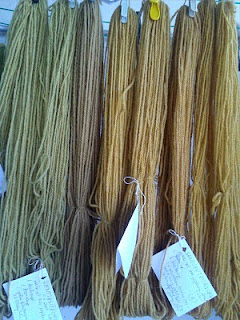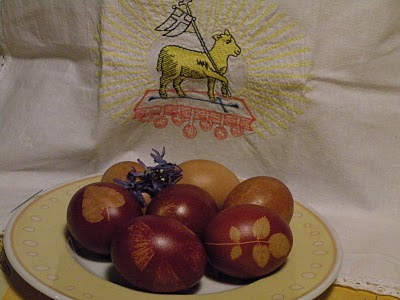
Spet sem nabirala cvetje šentjanževke - na maminem vrtu, ob poljskih poteh, na travnikih, v hribih, na zapuščenih zaraslih zemljiščih... Letos sem jih dobila izredno veliko in sem tudi barvala z njimi izredno veliko. Na volni sem dobila standardne barvne serije zeleno-vijolično-rjavo-zlato rumeno-limonino rumeno, z vršički s popki tik pred začetkom cvetenja pa tudi izjemno oranžne odtenke.
I collected St. John's wort flowers again - in Mum's garden, along field paths, in meadows, in the mountains, in waste areas... This year I got extreme quantities and also did extremely much dyeing with it. On wool it gave the standard colour series green - violet-brown - golden yellow - lemon yellow, but also extraordinary orange hues with tops with buds just prior to blooming.

Ker sem imela tako veliko materiala, sem se odločila za eksperimentiranje. Posebej sem barvala s cvetki (in popki), posebej z zeljo-listki in posebej z oskubljenimi stebli. Presenečena sem ugotovila, da barvilo vsebujejo prav vsi deli (samo korenina ne, kar sem ugotovila lani), seveda pa ga je zdaleč največ v cvetkih, skoraj nič manj v popkih, tudi zel ima precej barvila, pa celo oskubljena stebla. Kdo bi si mislil! Pa sem mislila, da so samo cvetki kaj vredni za barvanje. Na spodnji sliki je volna, barvana samo z zeljo. Realna barva je bolj v zgornjem delu slike oziroma, bolje rečeno - volna sploh ni lisasta, ampak lepo enakomerno obarvana.
Since I had so much material at hand I decided to experiment. I used separately flowers (with buds), separately the green parts without stems, and separately stems without flowers or leaves. I was surprised to find out that all the parts of the plant contain the dyeing substance (with the exception of roots, hich I found out last year), flowers being the richest in it, of course. The buds are almost as rich in dye, the leaves also contain much dye, and even the bare stems have some. Who would have thought it! And I was led to believe only the flowers are worth using for dyeing.
The picture below shows wool yarn dyed with green leaves only. The colour is more realistic in the upper section of the picture - or, to be more precise, the yarn is not variegated, the colour is solid. 
Nato sem se pogumno lotila barvanja bombažne preje za pletenje in vezenje ter bombažne in lanene prejice za klekljanje. Za to nisem nikjer dobila nobenih navodil, pa imam kar nekaj knjig o barvanju z rastlinami. Nekaj prejice za klekljanje sem barvala s šentjanževko že prejšnja leta, pa sem dobila tako različne rezultate, da nisem vedela, pri čem sem.
In me je res hudo presenetila. Medtem ko na volni po navadi daje standardne barvne serije, je na bombažu in lanu povsem nepredvidljiva.
Najbolj me je zanimala barva prve kopeli, ki na volni daje tako lepo zeleno. Na bombažu in lanu daje vse od zlato zelene, močne rumene, modrikasto zelene (prva slika levo), sive (druga slika desno).
I was encouraged and tackled dyeing cotton yarn for knitting and stitching and cotton/linen yarn for bobbin lace. I 'd found no instructions or description although I do possess a few books on natural dyeing. I had dyed some yarn for bobbin lace in previous years only to get results that were so inconsistent that left me perplexed.
I was perplexed again. While it yields standard colour sets on wool St. John's wort is quite unpredictable on cotton and linen.
I was mostly interested in the first dyeing in fresh dyeing bath that gives such a lovely green on wool. And what does it give - or at least gabe me - on cotton and linen: everything from golden green, intense yellow, bluish green (first pisture left corner) and grey (secong picture right corner).

Tudi barva kopeli se je letos obnašala čudno - pri eni seriji je po prvem barvanju z galunom čimžane preje kopel postala zelene barve in je taka ostala ves čas, pa sem pomakala in namakala kar precej prejic. Druga kopel, tudi prvo kuhanje samo cvetkov, pa ne !?!
The colour of the dyeing bath itself also behaved in a strange way this year: in one batch it turned green after the first dyeing of alum mordanted yarn and remained green throughout the dyeing session, and believe I did dip and soak and cook many a little skein of yarn. The other byth, also obtained by the first cooking of flowers only did not shift to green !?!
No, roke sem imela pa takele - ampak to nič ne boli in nič ne škodi in se v enem dnevu izmije.
And my hands looked like this - I didn't mind, it doesn't hurt nor damage the skin and is washed off within one day.

To še ni konec dosedanjega eksperimentiranja, ampak blog je že tako predolg, se bojim, da mi jo bo blogger kaj zagodel, zato raje objavim...
This is not yet an end to my experimentation - only my writing is too long already and I'm afraid the Blogger may play a nasty trick on me so I'm posting it...


 Pred časom sem dobila rdečkast lesni drobir v vrečki z napisom Rotholz (Wollknoll). Nekaj dni sem ga namakala v vodi, nato odlila tekočino in pobarvala prvo štreno (na levi). Ni mi bila všeč. Nato sem se lotila bombažnega blaga. Posula sem drobir (skupaj z rabljenimi koreninami barvilnega brošča), za nekaj dni prepustila soncu, da opravi nalogo barvanja in si dala delat bluzo (na spodnjih slikah). Ni mi bilo všeč.Končno sem za nasvet povprašala na Yahoojevi skupini NaturalDyes in drobir skuhala z malo kisa. Krasni vijolični odtenki, zelo močne barve - zelo lepo! Pobarvala sem tudi nekaj bombažne prejice (obešeni sta na ovratniku bluze na spodnjih slikah), pa še nekaj česane volne. Barva menda ni preveč obstojna na svetlobi, zato je bolje, da material, barvan s tem lesom, ni na direktnem močnem soncu in tudi ne dalj časa na sončni svetlobi. Some time ago I was given some reddish wood chips saying it was Rotholz (from Wollknoll). I soaked them in tap water for a few days, poured the liquid off and dyed the first skein (from left). Didn't like it. Passed on to cotton fabric, placed the chips all over (together with used madder roots), sundyed it for a few days and had a blouse made (the pictures below). Didn't like it. Finally I asked for advice in Yahoo group NaturalDyes and boiled the chips together with some vinegar. The lovely purples, very intense, quite dark - beautiful! I also dyed some cotton yarn (placed two skeins on the collar of the blouse to show) and some carded wool. The colour is said to have only medium to poor lightfastness so direct sunlight or prolonged exposure to sun is best avoided.
Pred časom sem dobila rdečkast lesni drobir v vrečki z napisom Rotholz (Wollknoll). Nekaj dni sem ga namakala v vodi, nato odlila tekočino in pobarvala prvo štreno (na levi). Ni mi bila všeč. Nato sem se lotila bombažnega blaga. Posula sem drobir (skupaj z rabljenimi koreninami barvilnega brošča), za nekaj dni prepustila soncu, da opravi nalogo barvanja in si dala delat bluzo (na spodnjih slikah). Ni mi bilo všeč.Končno sem za nasvet povprašala na Yahoojevi skupini NaturalDyes in drobir skuhala z malo kisa. Krasni vijolični odtenki, zelo močne barve - zelo lepo! Pobarvala sem tudi nekaj bombažne prejice (obešeni sta na ovratniku bluze na spodnjih slikah), pa še nekaj česane volne. Barva menda ni preveč obstojna na svetlobi, zato je bolje, da material, barvan s tem lesom, ni na direktnem močnem soncu in tudi ne dalj časa na sončni svetlobi. Some time ago I was given some reddish wood chips saying it was Rotholz (from Wollknoll). I soaked them in tap water for a few days, poured the liquid off and dyed the first skein (from left). Didn't like it. Passed on to cotton fabric, placed the chips all over (together with used madder roots), sundyed it for a few days and had a blouse made (the pictures below). Didn't like it. Finally I asked for advice in Yahoo group NaturalDyes and boiled the chips together with some vinegar. The lovely purples, very intense, quite dark - beautiful! I also dyed some cotton yarn (placed two skeins on the collar of the blouse to show) and some carded wool. The colour is said to have only medium to poor lightfastness so direct sunlight or prolonged exposure to sun is best avoided. 



























